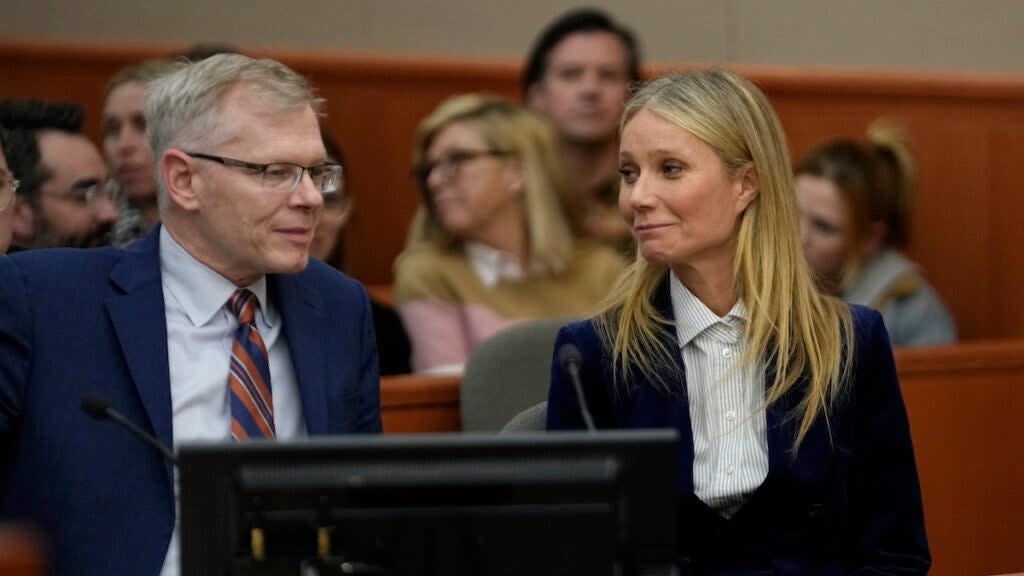Why Gwyneth Paltrow Risked a Very Public Ski Collision Trial – and Emerged Unscathed | Analysis

- Oops!Something went wrong.Please try again later.
Why would Gwyneth Paltrow submit herself to the risks of both a trial and the merciless court of public opinion instead of quietly settling a ski collision case, as most celebrities faced with similar situations opt to do? A public trial could tarnish both her image and her $430 million brand, Goop.
It took seven years to come to trial, eight days of testimony, and less than three hours for a jury in Park City, Utah, to determine that Gwyneth Paltrow wasn’t at fault for a skiing collision in 2016. Instead, the jury declared that 76-year-old retired optometrist Terry Sanderson, who brought a $300,000 suit against the Oscar-winning actress and Goop entrepreneur, was 100% at fault and owed Paltrow $1, the amount she countersued him for.
TheWrap spoke to several legal and PR experts who mostly concluded Paltrow saw this as a winnable battle for her reputation. And the gamble paid off.
“The verdict validates Paltrow’s certainty to litigate a case most celebs would have avoided,” said Los Angeles crisis PR expert Eric Schiffer, the CEO of Reputation Management Consultants.
Also Read:
Gwyneth Paltrow Wins Ski Crash Trial After Jury Returns Verdict in Less Than 3 Hours
Under cross-examination, Sanderson came across as a wealthy, privileged individual who was trying to cash in on Paltrow’s fame and fortune. Paltrow’s attorney put his claims of long-term debilitating injuries ostensibly sustained in the collision under a spotlight as the optometrist’s social media posts showed him enjoying trips around the world that included everything from zip-lining to camel riding after the accident.
Sure, Paltrow suffered some minor dings on social media with her responses to questions on the stand: how she missed half a day of skiing after the collision, paid $8,000 for her children’s ski lessons, said she was “shrinking” when asked about her height and dithered about the nature of her friendship with Taylor Swift. But those incidents didn’t dissuade the jury from believing her version of events or ultimately prove damaging to her reputation, experts said.
Ellie Heisler, an attorney with Nixon Peabody in Los Angeles who heads up the firm’s entertainment practice said that on the most basic level, Paltrow went to trial to prove that she was not at fault.
“As an entertainment attorney that works very closely with talent on their brands, I’m unsurprised by her decision to see this through,” Heisler said. “She [was] signaling to the world that she wants everyone to know ‘I did not do this.’ And she is willing to go through a trial all the way to the end to vindicate herself.”
There’s another practical reason to take a stand, Heisler said: “The more famous or rich you become, the bigger a target you have on your back. If you start settling cases and begin to have a reputation for throwing money at problems, it invites future lawsuits.”
Schiffer said that while Paltrow’s decision to go to trial may have seemed like a gamble, it was likely her legal team knew that the plaintiff wasn’t going to be particularly sympathetic or credible on the stand.
“There’s always a significant calculus about optics,” he said, “but Paltrow had an ace up her sleeve that she used to eviscerate Sanderson’s credibility and I believe her attorneys knew that going into this trial.”
“Paltrow’s attorneys did a lot of things right in this trial,” said Los Angeles entertainment attorney Tre Lovell. “They upped the emotional value by creating that animated video showing Sanderson slamming into Paltrow, which gave the jury something palpable to consider.”
Also Read:
Gwyneth Paltrow’s Jade-Egg Problems Delayed Her From Speaking Out About Harvey Weinstein, Book Says
Testimony from Paltrow’s children upped her “sympathy factor” and countered the testimony from Sanderson’s daughters, he added.
“By going with the flow and even trying to serve treats in the courtroom, Paltrow seemed to be taking a page or two from Martha Stewart,” said Howard Breuer, CEO of Newsroom PR. (The judge rejected her offer of treats.)
The lack of criminal charges meant there wasn’t a lot of “PR downside” for Paltrow, Breuer said. Instead, “fans [were] watching… wondering where they [could] buy her Caddis Hooper-style glasses.”
“The people that love her will continue to love her and think that she’s awesome for fighting,” Heisler said. “And the people that think perhaps she’s entitled or lives on her own planet are going to continue to think that, too.”
Lovell noted that Paltrow’s decision to countersue for just $1 “provided a good example of how to use positive branding alongside litigation. And overall, she walks away from this trial with her image more than intact. It’s actually been enhanced because of how she handled herself with poise.”
Even “the wackiness of her testimony” likely didn’t hurt Paltrow, said New York-based Lori Zelenko of LSZ Communications, a New York-based luxury marketing consultant. “Some are making fun of her but Goop sets her up for that anyway,” she said.
The wellness guru touts everything from using IVs to obtain nutrients, bone broth diets, to selling vagina-scented candles.
Also Read:
Goop Boss Gwyneth Paltrow Headed to ‘Shark Tank’
Ultimately, the verdict came down in Paltrow’s favor, and that’s something that can only be a net positive, all the experts said.
Lovell pointed out that not only was this a win for Paltrow, it also “supports the longstanding trend of celebrities getting a bit of deference from jurors in civil trials, even in a place like Utah where conservatism and religious faith run strong.”
“This is an instance where the court of public opinion mirrored the verdict — a huge vindication for Ms. Paltrow,” said Heisler.
And Zelenko quipped, “I imagine traffic to Goop is rising as fast as the good doctor was going down that ski slope.”
Also Read:
RIP Logo? Inside the Slow Death of Paramount’s LGBTQ Brand

